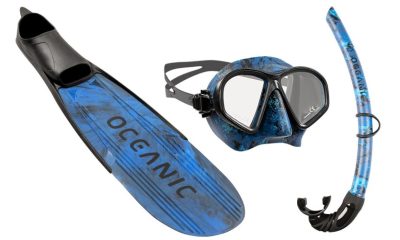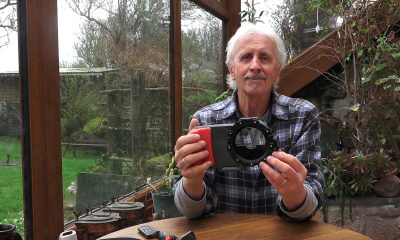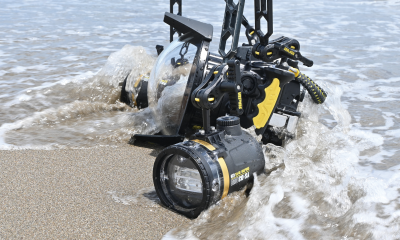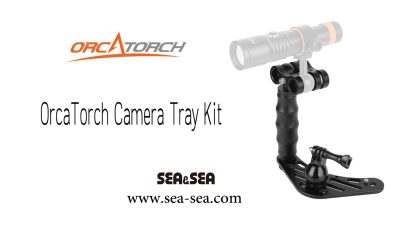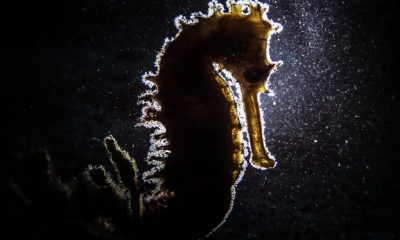News
SeaLife launches new underwater housing for iPhone
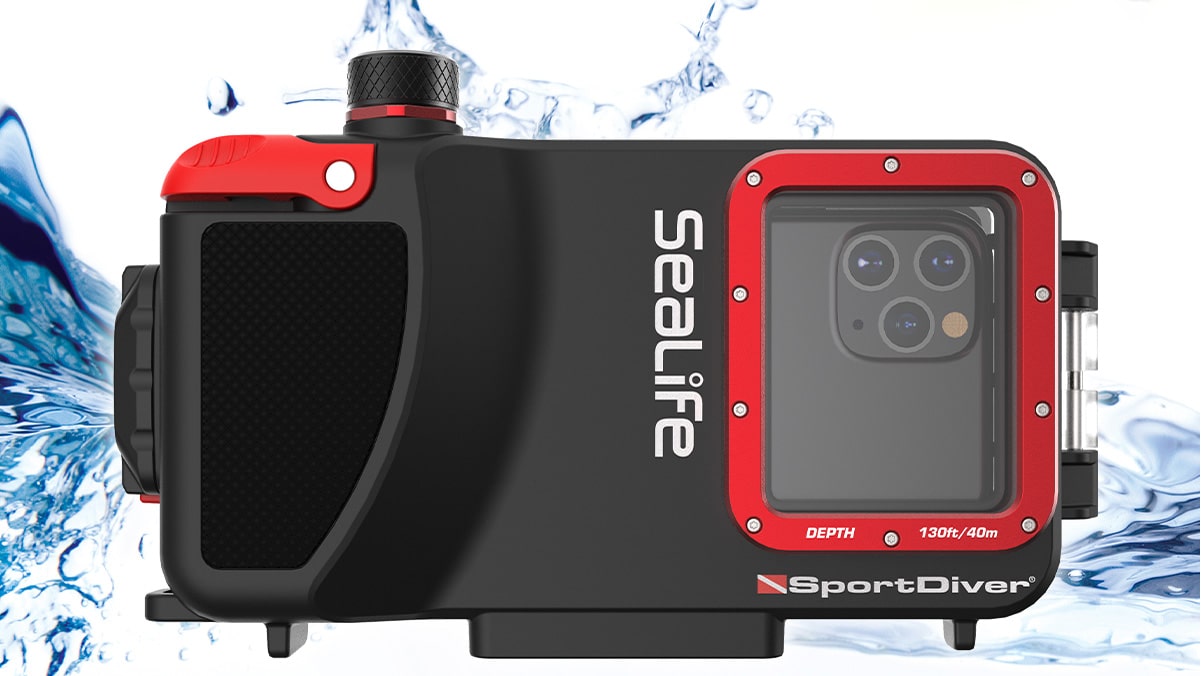
![]() SeaLife is introducing a new compact and lightweight underwater housing for Apple’s iPhone. The new SeaLife SportDiver housing will allow divers to take photos and video with their iPhone down to 130 feet or 40 meters. The SportDiver can encase iPhone 7, 7 Plus, 8, 8 Plus, X, Xr, Xs, Xs Max, 11, 11 Pro Max, and SE (2nd Gen) models.
SeaLife is introducing a new compact and lightweight underwater housing for Apple’s iPhone. The new SeaLife SportDiver housing will allow divers to take photos and video with their iPhone down to 130 feet or 40 meters. The SportDiver can encase iPhone 7, 7 Plus, 8, 8 Plus, X, Xr, Xs, Xs Max, 11, 11 Pro Max, and SE (2nd Gen) models.
The heavy-duty housing is constructed of Polycarbonate, stainless steel, aluminum and optical grade glass. And while the SportDiver housing is “heavy duty”, it is not heavy, weighing less than 1.5 pounds (641 grams), and is lightweight for travelling and offers almost neutral buoyancy in water depending on which iPhone model is used.
The SportDiver is easy to hold and use and offers a large shutter lever and rear control buttons for easy operation, even with dive gloves. Snorkelers and Divers can get more creative with their photos or video shot by using advanced camera settings. Adjust Zoom, Exposure (EV), Auto/Manual Focus, White Balance, Tint, Lens selection, RAW+JPEG mode, Live Photo and Background Blur (on available iPhone models).
The SportDiver housing includes the free SeaLife SportDiver camera app for iOS 12 and up and unlike other smartphone housing apps, there are no annoying in-app purchases or ads. You can easily switch between photo and video mode. The SportDiver App uses the iPhone camera technology native to each iPhone® model.
The App Playback mode shows full size photos and videos with vertical thumbnail strip to easily locate your images. Videos start playing automatically when selected. All files are also saved to iPhone camera roll. The SportDiver housing automatically connects to your iPhone and the SportDiver app using Bluetooth® Low Energy (LE) 5 wireless technology. No cables or buttons touch the phone and offers ultra-low power consumption for both the phone and the housing which is powered by two AAA batteries that last over 50 hours of continuous use.
For enhanced imaging results, a removable underwater color-correction filter is included with the SportDiver which restores natural underwater colors. The filter easily attached or removes underwater and includes a safety tether to prevent loss. The SportDiver housing features triple 1/4-20 tripod mounts which mounts to any light or light tray with standard tripod threads such as SeaLife’s own range of Sea Dragon underwater photo/video lights. SeaLife also offers the SportDiver and Sea Dragon underwater light combined dubbed the “SportDiver Pro 2500 Set”.
For the phone’s safety and protection, the SportDiver has a sturdy holding spring and rubber grip tabs that securely hold the iPhone® in place and add shock-protection. The SportDiver has “Dual Leak Alarms” which include an internal moisture alarm and a vacuum pressure alarm which alert the diver with on-screen warnings, audio and LED signal in the unlikely event the waterproof seal is compromised and there’s a loss of housing pressure or moisture is detected. The door of the SportDiver is sealed with a TPE O-ring and a robust cam-lock sealing latch that easily and securely locks waterproof door. To prevent interior fogging from residual moisture, the SportDiver uses the anti-fogging agent “Moisture Muncher” capsule which prevents fogging and internal condensation.
Deliveries of the SportDiver iPhone housing are planned to start in November, 2020.
Item Description US Retail
SL400 SportDiver Underwater Housing for iPhone $299.95
SL401 SportDiver Pro 2500 Set with Sea Dragon 2500 underwater light $649.95
Included with SeaLife SportDiver, Model SL400:
- SportDiver Underwater iPhone Housing
- Underwater Color-correction filter
- Vacuum pump
- Rubber Grip Tabs (12x Small, 12x Medium and 12x Large)
- Spare O-rings (1x Main O-ring and 1x Vacuum Check Port O-ring)
- O-ring lubricant
- O-ring removal tool
- Deluxe wrist strap with clip
- Moisture Muncher sample pack (1 capsule)
- AAA alkaline batteries (2)
- EVA Carry Case
Included with SeaLife SportDiver Pro 2500 Set, Model SL401:
- SportDiver Underwater Housing for iPhone, model SL400 as above
- Sea Dragon 2500 Underwater Photo/Video light, model SL671
- Sea Dragon 2500 Underwater Photo/Video Light head
- Flex-Connect Single Tray w/ standard ¼-20 mounting screw
- Flex-Connect grip
- 25Wh Lithium Ion rechargeable battery
- AC Power Adapter, charging tray, and international plug adapters
- Spare O-rings, O-ring lubricant, O-ring removal tool
- Sea Dragon EVA Case
For more information about Sealife Underwater Cameras visit the website by clicking here
News
Dive Worldwide Announces Bite-Back as its Charity of the Year

Over the next 12 months, specialist scuba holiday company Dive Worldwide will be supporting Bite-Back Shark & Marine Conservation with donations collected from client bookings to any one of its stunning dive destinations around the world. The independently-owned operator expects to raise £3000 for the UK charity.
Manager at Dive Worldwide, Phil North, said: “We’re especially excited to work with Bite-Back and support its intelligent, creative and results-driven campaigns to end the UK trade in shark products and prompt a change in attitudes to the ocean’s most maligned inhabitant.”
Bite-Back is running campaigns to hold the media to account on the way it reports shark news along with a brand new nationwide education programme. Last year the charity was credited for spearheading a UK ban on the import and export of shark fins.
Campaign director at Bite-Back, Graham Buckingham, said: “We’re enormously grateful to Dive Worldwide for choosing to support Bite-Back. The company’s commitment to conservation helps set it apart from other tour operators and we’re certain its clients admire and respect that policy. For us, the affiliation is huge and helps us look to the future with confidence we can deliver against key conservation programmes.”
To launch the fundraising initiative, Phil North presented Graham Buckingham with a cheque for £1,000.
Visit Dive Worldwide to discover its diverse range of international scuba adventures and visit Bite-Back to learn more about the charity’s campaigns.
MORE INFORMATION
Call Graham Buckingham on 07810 454 266 or email graham@bite-back.com
Gear News
Scubapro Free Octopus Promotion 2024

Free Octopus with every purchase of a SCUBAPRO regulator system
Just in time for the spring season, divers can save money with the FREE OCTOPUS SPRING PROMOTION! Until July 31st SCUBAPRO offers an Octopus for free
with every purchase of a regulator system!
Get a free S270 OCTOPUS with purchase of these combinations:
MK25 EVO or MK19 EVO with A700
MK25 EVO or MK19 EVO with S620Ti
MK25 EVO or MK19 EVO with D420
MK25 EVO Din mit S620Ti-X
Get a free R105 OCTOPUS with purchase of the following combinations:
MK25 EVO or MK19 EVO with G260
MK25 EVO or MK17 EVO with S600
SCUBAPRO offers a 30-year first owner warranty on all regulators, with a revision period of two years or 100 dives. All SCUBAPRO regulators are of course certified according to the new European test standard EN250-2014.
Available at participating SCUBAPRO dealers. Promotion may not be available in all regions. Find an authorized SCUBAPRO Dealer at scubapro.com.
More information available on www.scubapro.com.
-

 News3 months ago
News3 months agoHone your underwater photography skills with Alphamarine Photography at Red Sea Diving Safari in March
-

 News3 months ago
News3 months agoCapturing Critters in Lembeh Underwater Photography Workshop 2024: Event Roundup
-

 Marine Life & Conservation Blogs3 months ago
Marine Life & Conservation Blogs3 months agoCreature Feature: Swell Sharks
-

 Blogs2 months ago
Blogs2 months agoMurex Resorts: Passport to Paradise!
-

 Blogs2 months ago
Blogs2 months agoDiver Discovering Whale Skeletons Beneath Ice Judged World’s Best Underwater Photograph
-

 Gear Reviews2 weeks ago
Gear Reviews2 weeks agoGEAR REVIEW – Revolutionising Diving Comfort: The Sharkskin T2 Chillproof Suit
-

 Marine Life & Conservation2 months ago
Marine Life & Conservation2 months agoSave the Manatee Club launches brand new webcams at Silver Springs State Park, Florida
-

 Gear Reviews3 months ago
Gear Reviews3 months agoGear Review: Oceanic+ Dive Housing for iPhone




